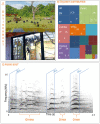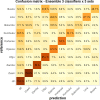Improving the workflow to crack Small, Unbalanced, Noisy, but Genuine (SUNG) datasets in bioacoustics: The case of bonobo calls
- PMID: 37053268
- PMCID: PMC10129004
- DOI: 10.1371/journal.pcbi.1010325
Improving the workflow to crack Small, Unbalanced, Noisy, but Genuine (SUNG) datasets in bioacoustics: The case of bonobo calls
Abstract
Despite the accumulation of data and studies, deciphering animal vocal communication remains challenging. In most cases, researchers must deal with the sparse recordings composing Small, Unbalanced, Noisy, but Genuine (SUNG) datasets. SUNG datasets are characterized by a limited number of recordings, most often noisy, and unbalanced in number between the individuals or categories of vocalizations. SUNG datasets therefore offer a valuable but inevitably distorted vision of communication systems. Adopting the best practices in their analysis is essential to effectively extract the available information and draw reliable conclusions. Here we show that the most recent advances in machine learning applied to a SUNG dataset succeed in unraveling the complex vocal repertoire of the bonobo, and we propose a workflow that can be effective with other animal species. We implement acoustic parameterization in three feature spaces and run a Supervised Uniform Manifold Approximation and Projection (S-UMAP) to evaluate how call types and individual signatures cluster in the bonobo acoustic space. We then implement three classification algorithms (Support Vector Machine, xgboost, neural networks) and their combination to explore the structure and variability of bonobo calls, as well as the robustness of the individual signature they encode. We underscore how classification performance is affected by the feature set and identify the most informative features. In addition, we highlight the need to address data leakage in the evaluation of classification performance to avoid misleading interpretations. Our results lead to identifying several practical approaches that are generalizable to any other animal communication system. To improve the reliability and replicability of vocal communication studies with SUNG datasets, we thus recommend: i) comparing several acoustic parameterizations; ii) visualizing the dataset with supervised UMAP to examine the species acoustic space; iii) adopting Support Vector Machines as the baseline classification approach; iv) explicitly evaluating data leakage and possibly implementing a mitigation strategy.
Copyright: © 2023 Arnaud et al. This is an open access article distributed under the terms of the Creative Commons Attribution License, which permits unrestricted use, distribution, and reproduction in any medium, provided the original author and source are credited.
Conflict of interest statement
The authors have declared that no competing interests exist.
Figures















References
-
- Coye C, Zuberbühler K, Lemasson A. Morphologically structured vocalizations in female Diana monkeys. Anim Behav. 2016;115: 97–105. doi: 10.1016/j.anbehav.2016.03.010 - DOI
-
- Mielke A, Zuberbühler K. A method for automated individual, species and call type recognition in free-ranging animals. Anim Behav. 2013;86: 475–482. doi: 10.1016/j.anbehav.2013.04.017 - DOI
-
- Aubin T, Mathevon N, editors. Coding Strategies in Vertebrate Acoustic Communication. Cham: Springer International Publishing; 2020. doi: 10.1007/978-3-030-39200-0 - DOI
Publication types
MeSH terms
LinkOut - more resources
Full Text Sources
Miscellaneous

